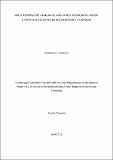| dc.description.abstract | Pastoralists consider wildlife the biggest competitors over resources for livestock while little
is known about the potentially positive or negative behavioural effects that livestock can have
on wildlife when foraging together. In the Ngorongoro Conservation Area (NCA), wildlife
has been grazing together with livestock for centuries but knowledge on how this impacts
wildlife feeding behaviour or grazing intensity on grass regrowth is scarce. Behavioural
observations of wildlife and livestock species were conducted from a vehicle driving along
transects within NCA. Four groups of wild herbivore species including plains Zebra (Equus
burchelli), Thomson’s gazelle (Gazella thomsonii), Grant’s gazelle (Gazella granti) and
Wildebeest (Connochaetes taurinus) were observed, grazing either with or without livestock
species, i.e., cattle (Bos taurus), goats (Capra aegagrus hircus) and sheep (Ovis aries), over
two different seasons. Out of 158 groups in total, on average 48 herds without and 31 herds
mixed with livestock were recorded. Moving cages were used to assess the effect of different
wildlife and livestock grazing pressure on grass regrowth (height and coverage). Results
show that wildlife decreased their foraging time while they increased vigilance behaviour
when grazing together with livestock, particularly when herders were present, compared to
grazing without livestock. The grass regrowth potential decreased with increasing grazing
intensity. Therefore, in contrast to foraging facilitation theory we conclude that the presence
of livestock does not seem to be beneficial for wild herbivores and that wildlife protection
area, in which pastoralists cannot lead their cattle, are important for a sustainable
management of the NCA. | en_US |


